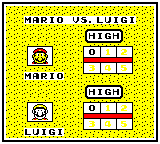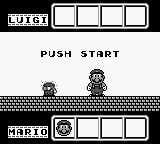Tetris
Tetris is a puzzle game for the Game Boy released in 1989 in Japan and North America and 1990 in Europe. It was developed by Nintendo and Bullet-Proof Software, and is directly based on Alexey Pajitnov's original rendition of Tetris. The basic gameplay involves stacking a series of blocks to create full rows with increasingly fast speeds. This simple gameplay, combined with its basic visuals, gave Tetris a universal appeal that made it immensely popular. It massively helped sell the Game Boy by virtue of being bundled with it upon release.
Tetris was rereleased for the Game Boy Color under the name Tetris DX. It was also made available for the Nintendo 3DS's Virtual Console in December 2011, although the title was later pulled from all regions.
The Nintendo Entertainment System version of the game also has Mario characters cameo on the end screen.
Gameplay
The goal of the game is to stack blocks into complete lines, removing them from play. All of the blocks, called Tetriminos[1], are based on the tetrominos (every geometric shape that can be created from four perfect squares). As play begins, a random Tetrimino falls to the bottom of the screen, and the player can position it and rotate it without being able to move it back up. After one is placed down, another appears, and this continues for every subsequent Tetrimino. In single-player, the player can choose from the A-Type or B-Type modes to play. In A-Type, the player selects the speed at which the Tetriminos fall, then the game begins. It continues forever[2] until the Tetriminos reach the top of the screen, with no more room left for them to appear. In B-Type, the player must clear twenty-five lines, and in this mode, they can choose both the Tetrimnos' falling speed and the number of misaligned blocks that are already on-screen. Once the necessary lines have been cleared, the player is scored on their performance. If they complete B-Type with the maximum settings, a special ending plays featuring the launch of a spaceship.
Multiplayer features only two players, and pits Mario against Luigi as they stack Tetriminos on separate fields. If one player clears more than one line, extra lines suddenly appear at the bottom of the other player's screen. Play continues until either one player runs out of space or one player clears at least thirty lines, at which point Mario and Luigi are seen celebrating or moping. The games then begin anew, with a cleared screen, until one player wins three times.
Development
Rogers convinced Arakawa by saying that Tetris would appeal to everyone, whereas Mario would only appeal to kids. As he put it, "[i]f you want little boys to buy your machine include 'Mario,' but if you want everyone to buy your machine, include 'Tetris'".[3]
Reception
Critical reception
| Reviews | |||
|---|---|---|---|
| Release | Reviewer, Publication | Score | Comment |
| 3DS | Lucas M. Thomas, IGN | 9.0/10 | "Tetris endures. It was one of the greatest video games ever made when it first appeared back in the '80s, and it retains that status to this day. This particular version of Tetris just adds to that sense of awe, as it's inarguably the most important and nostalgic edition of the game ever published." |
| Game Boy | Marc Golding, Honest Gamers | 10/10 | "To summarize the Tetris experience is to quote Maynard James Keenan of the great rock band Tool -- as I am often wont to do: I know the pieces fit!" |
| Game Boy | Adam Riley, Cubed3 | 10/10 | "Tetris is one game that will never be forgotten, no matter how many pretenders to the thrown come and go over time. Sure, there may be some games that have actually managed to improve on the idea, but the original still stands out as one of those revolutionary games. I should not have to tell you to play this, as the majority already will have in some form or other..." |
| Game Boy | Victor Lucas, Electrical Playground | 10/10 | "Although we're talkin' moving different shapes around and fitting them into the proper positions, Tetris stands as one of the best videogames ever made. The Game Boy would be the Game Infant without it." |
| Aggregators | |||
| Compiler | Platform / Score | ||
| GameRankings | 89.73% (GB) | ||
Sales
The popularity of Tetris was immense, to the point where the success of the Game Boy is often attributed to Tetris itself[4][5]. In no small part because the game was bundled with the Game Boy, it sold over 33 million copies[6], and its combined earnings was billions of dollars[7]. The game has thus gained a reputation as the handheld's "killer app"[8]. Although the game succeeded with Nintendo's core demographic of young children, the game was notably popular with people outside of their usual audience, such as businessmen and other non-traditional gamers, and Nintendo began marketing the game towards them[6][9].
Legacy
Tetris holds the distinction of being the first video game played in space, by Russian astronaut Aleksandr Aleksandrovich Serebrov[10]. The astronaut received the game from Nintendo's then-chairman, Howard Lincoln, while the latter was on a trip in the USSR to see Pajitnov[11].
References
- ^ "About Tetris®." Tetris, tetris.com/about-us. Retrieved January 26, 2017.
- ^ Spectre255. "Game Boy Tetris - 999,999 Points." YouTube, 13 Mar. 2006, www.youtube.com/watch?v=keeSEJG4XzU. Retrieved January 26, 2017.
- ^ Levy, Karyne. "The Complicated History Of 'Tetris,' Which Celebrates Its 30th Anniversary Today." Business Insider, 6 June 2014, 10:59 AM, www.businessinsider.com/tetris-history-2014-6.
- ^ Kaplan, Arie. "Games To Go." The Epic Evolution of Video Games, Lerner Publications Company, 2014, p. 15. ShockZone — Games and Gamers. Google Books, books.google.ca/books?id=ACejAgAAQBAJ.
- ^ Rollings, Andrew, and Dave Morris. Game Architecture and Design, New Riders, 2004, p. 538. Google Books, books.google.ca/books?id=qFdzalo0ixcC.
- ^ a b Haghirian, Parissa, and Philippe Gagnon. "The Handheld Market." Case Studies in Japanese Management, World Scientific, 2011, pp. 61-62. Google Books, books.google.ca/books?id=Lx08DQAAQBAJ.
- ^ Sheff, David. Game Over: How Nintendo Conquered The World. Knopf Doubleday, 2011. Google Books, books.google.ca/books?id=b_N5FzzD3hsC.
- ^ Bellomo, Mark."Bricks and Pocket Monsters." Totally Tubular '80s Toys, Krause, 2010, p. 348. Google Books, books.google.ca/books?id=CF8AjVJXvH0C.
- ^ Loguidice, Bill, and Matt Barton. "Nintendo Game Boy (1989)." Vintage Game Consoles: An Inside Look at Apple, Atari, Commodore, Nintendo, and the Greatest Gaming Platforms of All Time, CRC Press, 2014. Google Books, books.google.ca/books?id=wZnpAgAAQBAJ.
- ^ Plunkett, Luke. "This Game Boy Has Been to Space. For Real." Kotaku, 4 May 2011, kotaku.com/5798377/this-game-boy-has-been-to-space-for-real. Retrieved January 22, 2018.
- ^ Nintendo Staff. "A Link With The Soviet Union." Nintendo Power, 1989, p. 54.
| Game Boy games | |
|---|---|
| Super Mario franchise | Alleyway (1989) • Baseball (1989) • Super Mario Land (1989) • Golf (1989) • Dr. Mario (1990) • Super Mario Land 2: 6 Golden Coins (1992) • Donkey Kong (1994) • Mario's Picross (1995) • Picross 2 (1996) |
| Donkey Kong franchise | Donkey Kong (1994) • Donkey Kong Land (1995) • Donkey Kong Land 2 (1996) • Donkey Kong Land III (1997) |
| Yoshi franchise | Yoshi (1991) • Yoshi's Cookie (1992) • Tetris Attack (1996) |
| Wario franchise | Wario Land: Super Mario Land 3 (1994) • Wario Blast: Featuring Bomberman! (1994) • Wario Land II (1998) |
| Miscellaneous | Tetris (1989) • The Legend of Zelda: Link's Awakening (1993) • Game & Watch Gallery (1997) • Game & Watch Gallery 2 (1997) |


